Caramelized Shallot Pasta is slightly sweet and full of addictive umami perfection. This pasta is fancy enough to make for guests and is total Italian comfort food. Spicy and savory, this will become your new favorite pasta recipe!
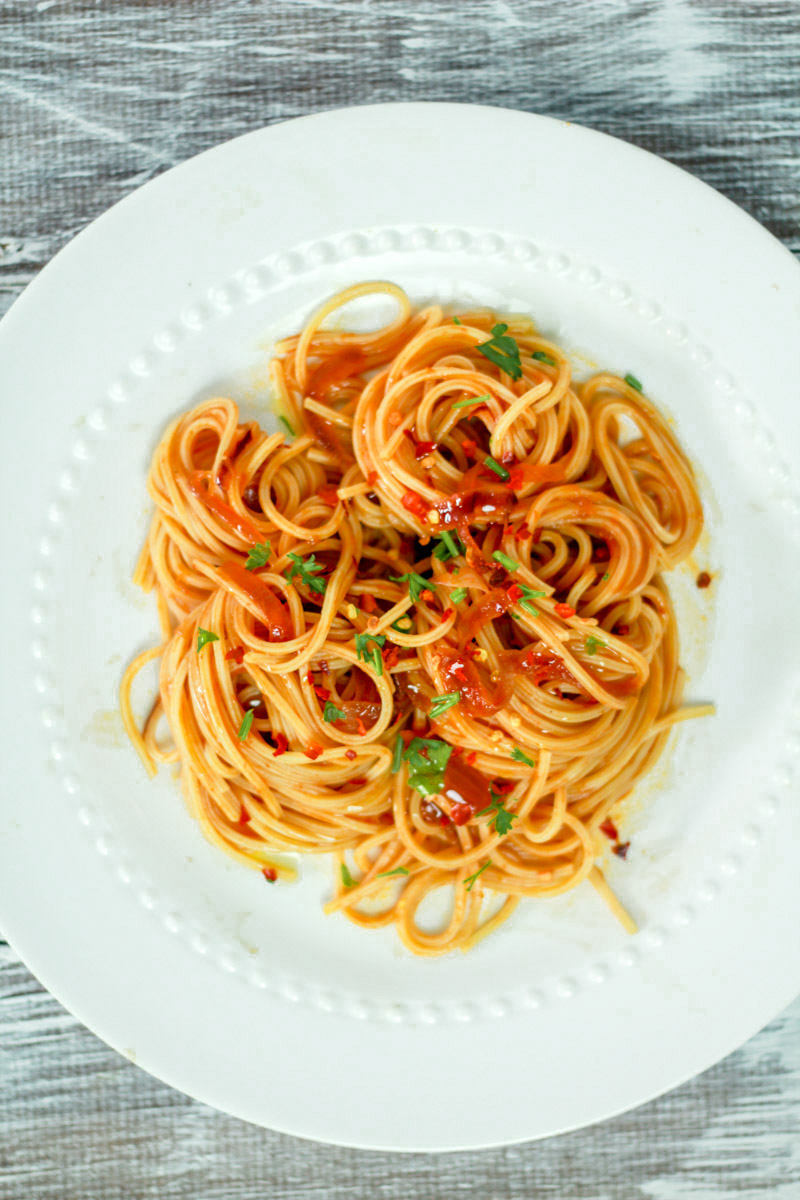
The amazing sauce that comes together with pantry ingredients is all smoothed out with a couple of ladles of salty pasta water and a bit of smooth tomato sauce. This is a long post...feel free to jump down to the full recipe if you're rushing!
I’ve been wanting to make this recipe for a really long time. I typically do not make a sauce alone with tomato paste. But I do caramelize onions all the time and add them to every thing! So this dish was dreamy with the sweetness of the caramelized shallots, subtle acid of the tomato paste and the unique saltiness from the anchovies. All melding together in the pan with some of the pasta water. But it wasn’t enough for me.
I know. One of the most viral recipes. The recipe known as "the Pasta" and was #1 recipe on NY Times last year. But something was off! I did make it the first time following the infamous recipe to a T. I often smooth out sauces with some ladles of pasta water. But something was missing...there was just not enough flavor wise for me (and the kids).
From that point on I made it with my adjustment of adding tomato sauce to it. The kids were way more impressed with the 2nd version with a bit of tomato sauce added in.
If you make it the original version, you’re basically making a caramelized shallot tomato jam. Which is nice to have on hand to add to recipes. But to serve with a pound of pasta, it wasn’t working for me. BUT...you may like it like that, and if so, try it without adding a little bit of tomato sauce.
The most difficult part of the recipe is slicing all the shallots and patiently stirring them to become magical from caramelizing. It does use a whole jar (or tube)of tomato paste. The pasta water and the addition of the sauce does smooth it all out. The sauce is slightly sweet, salty and totally balanced.
Originally published October 2021 and updated January 2024
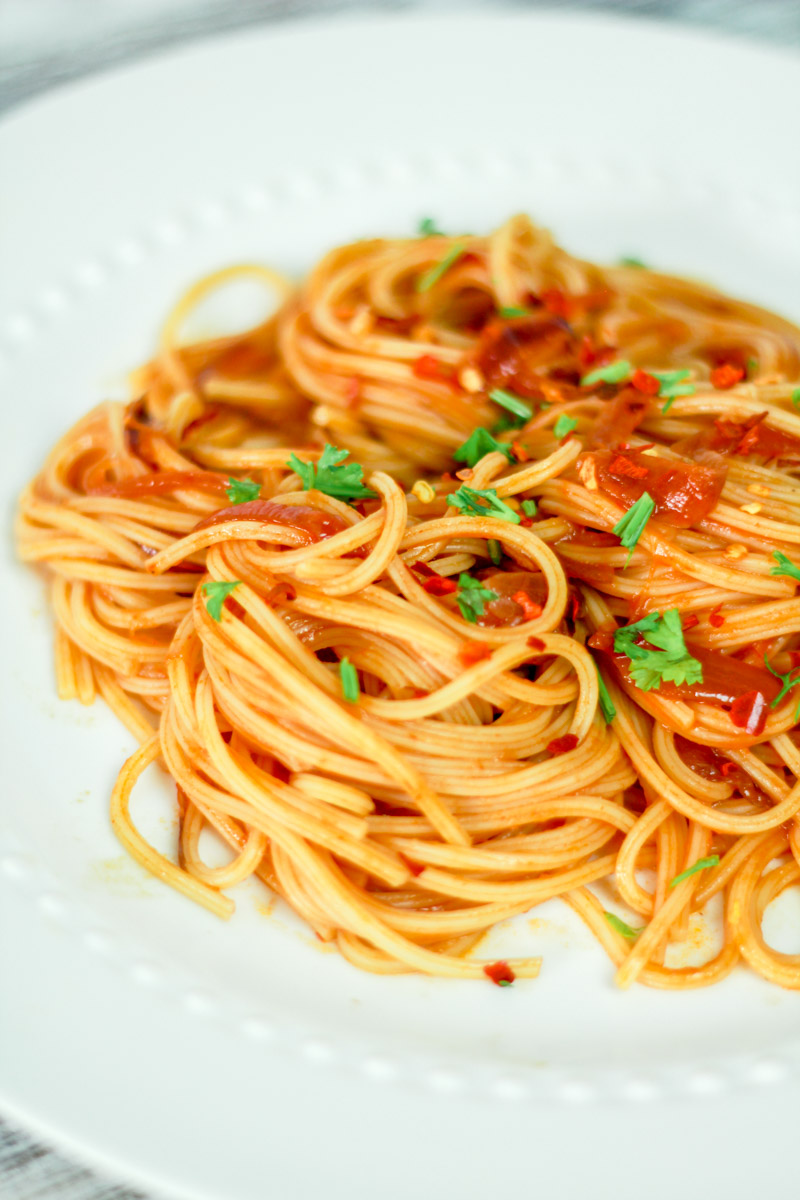
When we made the first time, we used half of the sauce, and my kids wanted more! So if you are making this for two, you will have extra sauce, and just make 10 ounces instead of 16 ounces of pasta (or make the whole thing and have leftovers). We were four, and some had seconds, so we used the entire pan of sauce for the pound of pasta.
Jump To
- Why we love this anchovy pasta recipe
- What ingredients do you need?
- How to make pasta with shallots (step-by-step)
- How to cook a shallot?
- FAQ'S
- Best Tips for making Caramelized Shallot Pasta
- Variations/Substitutions
- How to store this pasta:
- Serving Suggestions
- Some other pasta recipe to try:
- Caramelized Shallot Pasta
Why we love this anchovy pasta recipe
- Pantry staples: What I love about this recipe is that it’s made with ingredients I typically have on hand…and you may be surprised to already have all the ingredients in your pantry!
- Weeknight pasta: This is a super simple Italian pasta recipe that requires a little patience to get the flavors to develop. The recipe will be ready in under an hour (depends on how you caramelize your shallots). If you do it on higher heat, will definitely be ready sooner.
- Packed with flavor: We are talking an overload of UMAMI…al that salty goodness that makes you make this dish over and over again!
- ANCHOVIES: Yes, this should be under “packed with flavor” area (but it’s NOT fishy flavored)…but listen, anchovies are amazing! I happened to have a jar from Calabria packed in hot Calabrian peppers. But you can use whatever you find at the market. And they’re not expensive!!
- Comfort food: Yes, all pasta dishes for me are total comfort (at least for me!). It’s a simple pasta, but one that would impress any company you have over! This delicious pasta dish is a comforting meal on a cold winter's day (and so easy to put together!!).
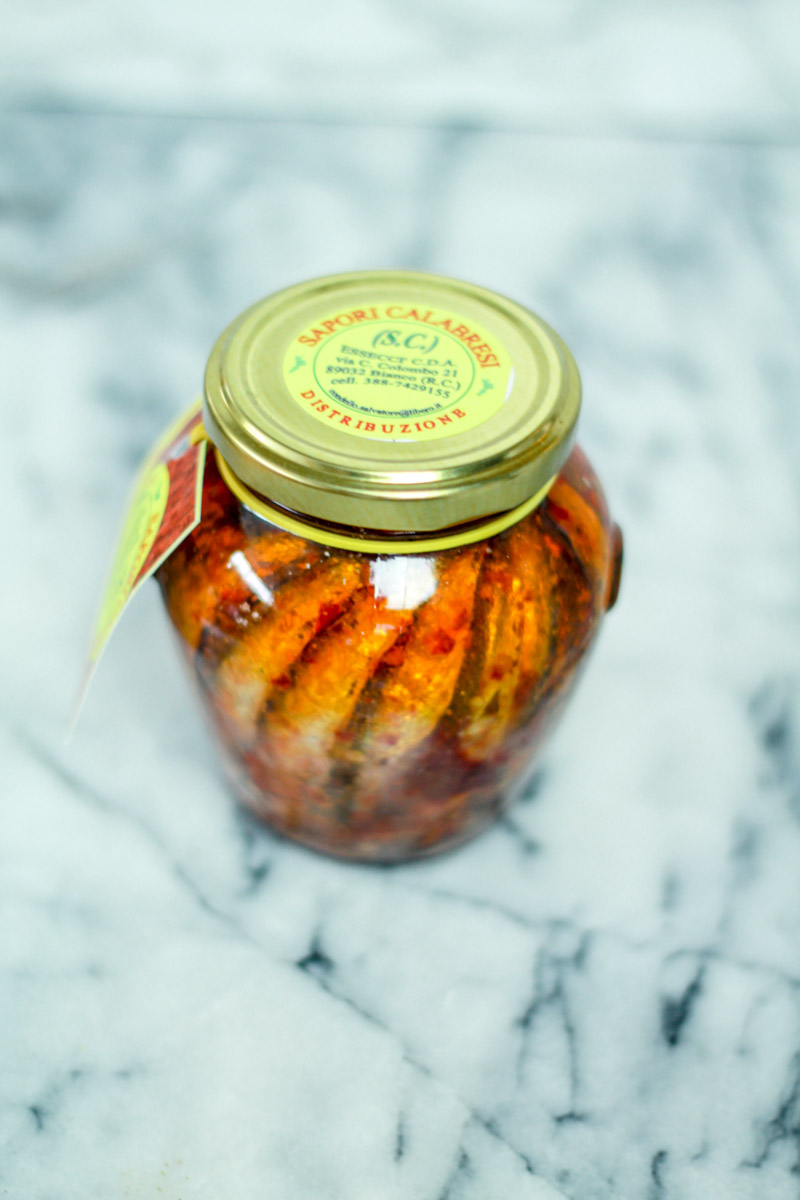
What ingredients do you need?
- Extra-virgin olive oil - Used to sauté the shallots and create a flavorful base for the sauce.
- Large shallots - Provide a sweet, delicate flavor that forms the base of the sauce.
- Sugar - Used to balance the acidity in the sauce.
- Balsamic vinegar - Adds a hint of sweetness and acidity to the sauce (optional).
- Coconut aminos - Provides a subtle umami flavor to the sauce (optional).
- Sea salt - Enhances the flavors of the other ingredients.
- Freshly ground pepper - Adds a bit of heat and depth to the sauce.
- Garlic clove - Provides a robust flavor to the sauce.
- Anchovy fillets - Adds a rich, umami flavor to the sauce.
- Tomato paste - Thickens the sauce and concentrates the tomato flavor.
- Tomato sauce - Creates the body of the sauce. Can be omitted if a thinner sauce is desired.
- Pasta - The primary ingredient that the sauce is served with.
- Red pepper flakes - Adds a spicy kick to the pasta.
- Salt for the pasta water - Salting the pasta water flavors the pasta itself.
- Italian flat leaf parsley - Used as a garnish and provides a fresh, herbal note to balance the rich sauce.
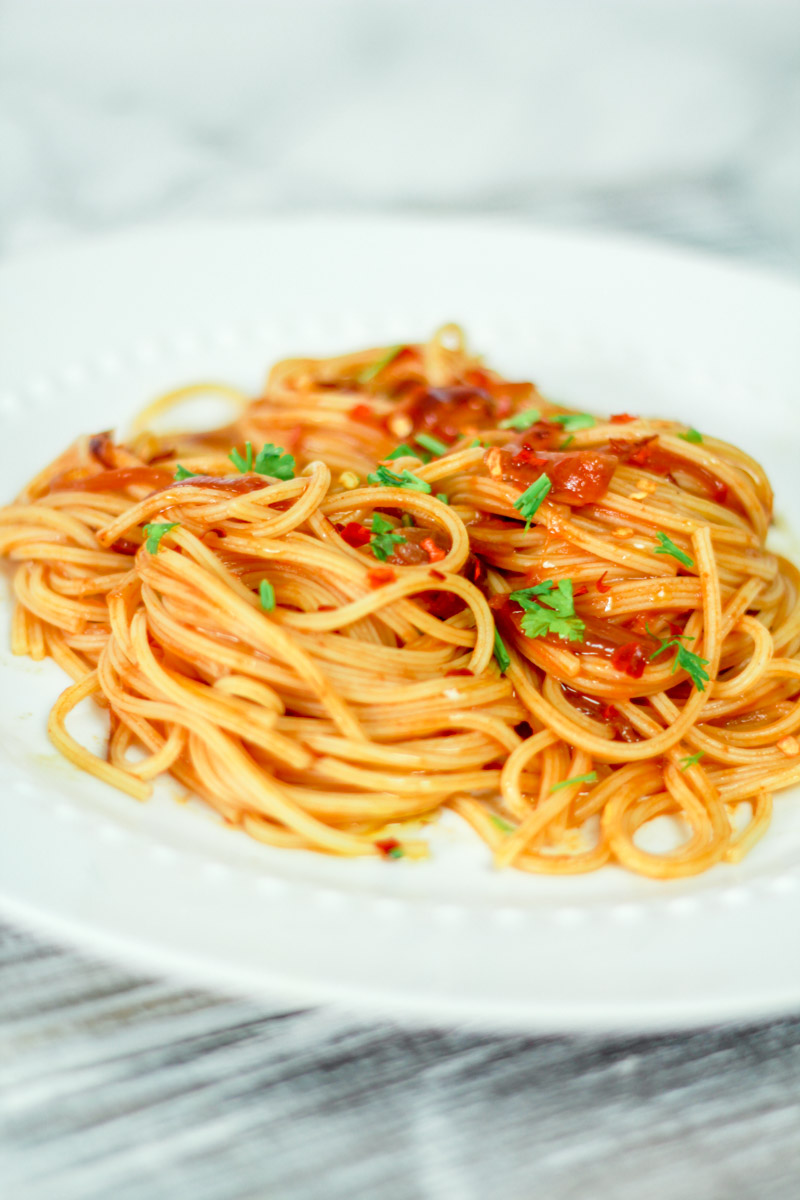
How to make pasta with shallots (step-by-step)
- Begin by bringing a sizeable pot of salted water to a boil for your pasta. Add the pasta and cook it until it is just shy of al dente readiness. This should take about 8-10 minutes, depending on the pasta type and brand. Be sure not to cook it fully as it will continue to cook in the sauce later.
- As your pasta cooks, you can start preparing the sauce. Heat a generous amount of extra-virgin olive oil in a large pan over medium heat. Add the finely chopped shallots to the pan and sauté them until they are soft and golden.
- Add a pinch of sugar to the shallots to balance the acidity in the sauce. Stir in the optional balsamic vinegar and coconut aminos for added sweetness and umami flavor. Season with sea salt and freshly ground pepper to taste.
- Press a garlic clove and add it to the pan, along with the anchovy fillets. Stir until the anchovies break down and dissolve into the sauce.
- Stir in the tomato paste until it's well blended with the shallots and garlic. Pour in the tomato sauce to create the base of your sauce. If you desire a thinner consistency, feel free to omit this step.
- When your pasta has reached its desired doneness, drain it but reserve some of the pasta water. Add the pasta to the pan with the sauce, tossing it well to ensure every strand is coated. If the sauce appears too thick, add a bit of the reserved pasta water to thin it out.
- Transfer your pasta to a serving bowl or platter and give it a final drizzle of quality extra-virgin olive oil for extra flavor.
- To serve, sprinkle some chopped Italian flat leaf parsley over the pasta for a fresh, herbal note. If you like a bit of heat, sprinkle on some red pepper flakes as well. Enjoy your meal!
How to cook a shallot?
To begin caramelizing, you first add olive oil to the pan. But as the shallots are softening, the trick is to add small portions of water. Otherwise, they’re sticking too much to the pan and you can’t keep adding oil. Basically, I add water about 3-5 times while it’s caramelizing. Also important, to keep those onions moving! You have to keep stirring them. So it’s adding water and deglazing pan and stir, stir, stir!
The best way to know is by keeping a very close eye on the pan. Don’t leave them there and walk away (they will burn!). I added a touch of sugar, balsamic vinegar and coconut aminos to the caramelized shallot mixture.
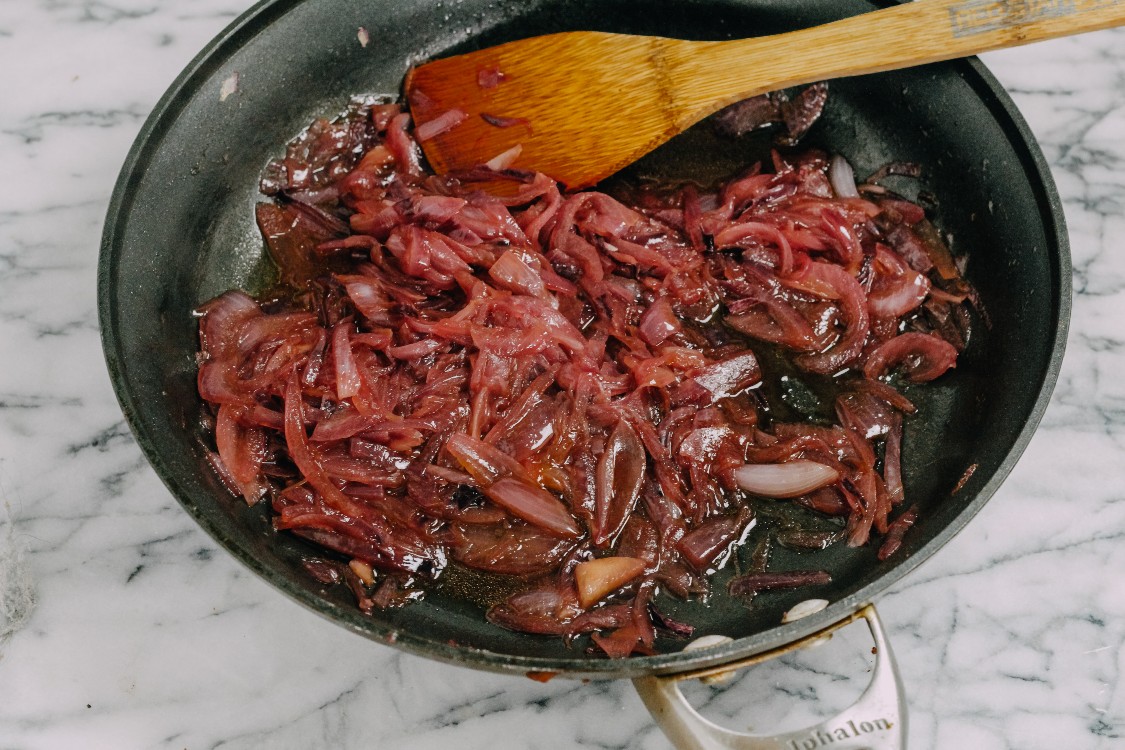
The shallots after about 20 minutes are so will begin to turn a nice golden brown color and they’ll soften up nicely. Once you’re at the phase where they have that gorgeous color, if you’re using garlic, add in the garlic (if you add at the beginning, the garlic will burn!).
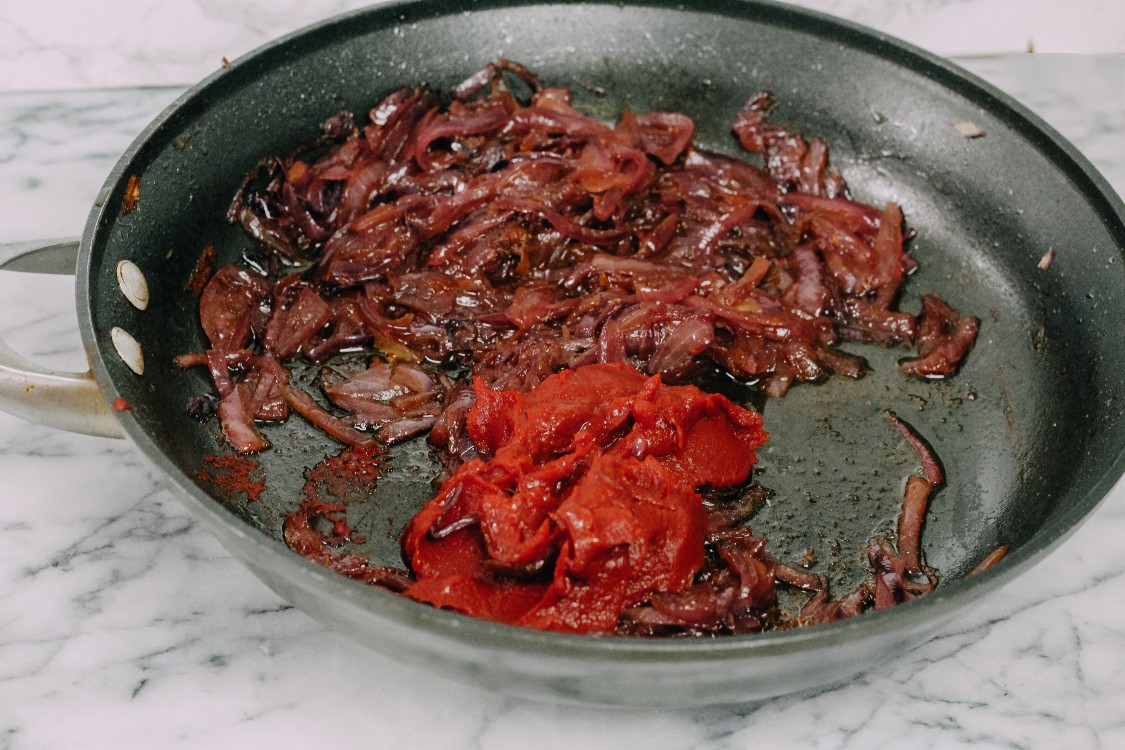
FAQ'S
Yes! If you leave out the anchovies, you could sub it with something called umeboshi paste. That is a paste made from Japanese fermented plums and is the perfect vegan substitute.
Another idea is to use nutritional yeast to get those umami notes that has a slight cheese flavor and also some chopped sun dried tomatoes.
Umami in Japanese means "pleasant savory taste". It's the fifth basic taste that became popular only starting with research about it in the 1980's.
You find umami elements in anchovies, pork, beef, tomatoes, cheese, and soy sauce. Also, broths, cheese, and gravies are full of umami flavor.
This could seem like a silly question, but it’s not! One shallot is the whole bulb. And you may find a bulb with two cloves inside…that’s one shallot. One large shallot is equivalent to 1/2 cup sliced. SO it’s about 3 cups of sliced shallots. IF you are using onions, it would be about 2 large onions (you’re still aiming for 3 cups total).
Best Tips for making Caramelized Shallot Pasta
- Recipe timing: The pasta typically could take about 10 minutes or so (depends on the brand and the shape of the pasta). It really doesn’t matter if the sauce is ready a few minutes or so before the pasta. Actually, I prefer to have the sauce ready and on a low temperature waiting for the pasta to cook up.
- Onions instead of shallots: Honestly, you could use even onions (white, red, or sweet)! I have made this with red onions. I have made this with red onions and shallots (like my photos you see today). You are caramelizing the onions as you do the shallots.
- It’s not that big of a flavor difference. Shallots are more expensive than onions. If you prefer to use even white onions for this recipe, it is economical and will turn out delicious! If you have sweet onions on hand, use them…they taste similar to shallots. Caramelizing sweet onions brings out their natural flavor and makes them even sweeter.
- Cutting shallots: Cut the shallots into rings. That’s the best way to cut them to caramelize. It ends up being about one pound of shallots (I did mixture shallot and red onions).
- Caramelizing shallots (onions) at higher heat: The best method to caramelized onions is LOW and slow, so they do not burn. I had the temperature on a medium-high heat so it can cook up quicker. And maybe your stove is better at medium heat (every stove is different).
- Garlic: So I use WAY less than original recipe calls for. Original has 6 cloves. I used one clove, as I wanted to really taste the caramelized shallots/onions and not have it be overpowered with garlic flavor. BUT if you love garlic, use 6 cloves!
- Anchovy fillets: It doesn’t matter what brand you buy. They have them at every market and there are also fancier ones. I happened to have a jar from Calabria and they were in Calabrian hot peppers. You really cannot taste a fishy flavor. The anchovies melt into the sauce. It just gives it the kick of umami that makes this sauce even more special!
- Use a full can or tube of tomato paste: I have made this recipe with a full can and also a half a can. The goal is to also cook the tomato paste a bit. It really releases the warmth of the tomato’s flavor. You want to also keep an eye on this part and make sure it does not burn. If you can find tomato paste in a tube, that’s ideal (better flavor).
- A touch of tomato sauce: I made this pasta the original version (where it is like a tomato paste/shallot jam)and also, I’ve made this thinning out the sauce with about a cup of tomato sauce (very good quality sauce for better flavor). It’s up to you if you want to add a little sauce, or not!
- Reserve some pasta water: This is the trick to many an amazing pasta sauce (AKA liquid GOLD). I usually save 3/4 to one cup of the water. This water has the starch from the pasta. This is the best way to thin out the shallot and tomato paste sauce and combine with the pasta (it’s starchy so it won’t make the pasta runny and has a bit of salt that you add to cook the pasta).
Variations/Substitutions
- Vegetarian Variation: Replace anchovy fillets with a combination of olives and capers for a similar salty kick. Opt for a plant-based pasta to keep the dish vegan.
- Gluten-Free Variation: Use a gluten-free pasta of your choice, such as chickpea pasta or brown rice pasta, without altering the taste and texture significantly.
- Low-Carb Variation: Substitute regular pasta with spiralized vegetables like zucchini or carrots, or use a spaghetti squash for a low-carb, veggie-filled alternative.
- Dairy-Free Variation: For a creamy version without dairy, create a sauce by blending cooked cauliflower with garlic and nutritional yeast, then mix it through the pasta.
Substitutions:
- Shallots can be replaced with leeks or spring onions for a milder flavor.
- Olive oil can be substituted with avocado oil or grape seed oil.
- Swap out the sugar for honey or maple syrup for a natural sweetener.
- Substitute coconut aminos with soy sauce or tamari.
- Replace tomato paste and sauce with fresh tomatoes, roasted and blended into a sauce.
- Red pepper flakes can be replaced with freshly sliced chili or a dash of hot sauce for a spicy kick.
Optional Additions:
- Add grilled chicken or shrimp for a protein boost.
- Toss in some sautéed mushrooms or roasted bell peppers for extra veggies.
- Top with a sprinkle of parmesan or feta cheese for extra creaminess.
How to store this pasta:
Once the pasta has cooled, store it for a few days in the fridge in an airtight container. I do not recommend freezing it. The shallot/paste sauce will stay fresh for up to 5 days.
Serving Suggestions
- Italian Stuffed Zucchini Flowers: These are stuffed with mozzarella and goat cheese, dipped in a light batter, and fried. A delicious summer bite that makes a perfect appetizer. They can be served on a platter with bruschetta or crostini, or even as a first course.
- Traditional Peperonata (Sauteed Peppers and Onions): This dish can be served as a delicious appetizer, especially when accompanied by a cheese board and some salami. It can also be used as a topping for bruschetta.
- Quick and Easy Italian Grilled Eggplant (Melanzane Grigliate): This versatile dish can be served as a side or added to a mixed antipasti platter. Chopped grilled eggplant can also be incorporated into a pasta recipe or bruschetta with chopped tomatoes
Some other pasta recipe to try:
- Pasta with Ricotta and Peas
- Vegan Pumpkin Pasta with Sage
- Antipasto Pasta Salad
- Pasta con le Sarde
- Easy Caramelized Onions (with Balsamic)
- Sweet Summer Corn and Cucumber Salad
Did you make this? Please RATE THE RECIPE below:)
Please Subscribe and give a follow on Instagram, Facebook, Pinterest, and TikTok xx
Caramelized Shallot Pasta
Ingredients
- ¼ cup extra-virgin olive oil
- 6 large shallots sliced in rings (it’s about 3 cups sliced very thinly, or red, white or sweet onion or a combo of shallots and onions)
- 1 tsp sugar
- 2 Tablespoons balsamic vinegar optional
- 1 Tablespoon coconut aminos optional
- 1 tsp sea salt
- 1 tsp freshly ground pepper or more to taste
- 1 garlic clove sliced thin
- 1 can 2 oz can anchovy fillets
- 1 can 6 oz tomato paste
- 1 cup tomato sauce omit if you want it to be only thinned out with pasta water
- 16 oz pasta I used spaghetti rigati, but you could use regular spaghetti or bucatini
- 1 tsp red pepper plakes
- salt for the pasta water
- Optional garnish:
- 1 cup Italian flat leaf parsley finely chopped ( I used fresh)
Instructions
- Fill a large pot with water and add salt. You’ll be bringing it to a boil to cook the pasta when the sauce is almost done.
- In a 12-inch skillet or a Dutch oven, heat the olive oil to medium to medium-high heat (every stove is different). Add the thinly sliced shallots (or whatever onion you are using). Begin to stir and season with some salt. Add the sugar. Keep stirring (don’t leave the pan!) and after the first 5-7 minutes, add a bit of water to deglaze.
- Continue cooking and stirring, adding water every few minutes or so (you know when the shallots dry up again. This helps to prevent burned shallots). Once they are a nice and golden brown (could take between 15-30 minutes), stir in garlic (if you’re using). Add the balsamic vinegar and coconut aminos. If needed, add a bit more water to deglaze and keep stirring until the garlic is soft and a nice golden color).
- Add in the anchovies and red pepper flakes (if you’re making this spicy). Stir the anchovies into the shallots. They will dissolve pretty quickly and combine with the shallots.
- Add the tomato paste and stir constantly, cooking the paste until it changes from bright red to a deeper and darker or until the paste has caramelized and become darker, 2-3 minutes. If you’re adding sauce, this is when you add about 1 cup of tomato sauce (I liked adding the sauce as I feel it makes it smoother. But you could do without sauce and just add the reserved pasta water). Taste the sauce and add a little more salt (if needed)and some freshly ground pepper. At this point, the sauce is almost ready, so it’s time to cook the pasta.
- Bring the large pot to a boil and add your pasta. Cook according to the pasta directions, but you are making the pasta al dente (I usually cook it a little less than al dente because I am combining the pasta with the sauce in a hot pan and it will continue cooking a little more).
- When pasta is ready, drain (reserve about 1 cup pasta water). Add the pasta to the skillet with the sauce and use tongs or a spoon to combine the pasta in the sauce. If you added some tomato sauce to the shallot mixture the sauce should be a nice texture, and you may need only about 1/4-1/2 cup pasta water.
- If you didn’t add tomato sauce, add some of the reserved pasta water (you’ll probably use a whole cup) and stir together with the pan on the heat (be sure not to keep it too long on the heat as you don't want the pasta to overcook and get mushy). Check the seasoning and add more salt, if needed, and freshly ground pepper.
- The stove should be on a medium-high heat and this shouldn’t be for more than 2 minutes (that’s why I like to undercook it before al dente readiness).
- Add the pasta to a serving bowl or platter. Drizzle on some really good extra-virgin olive oil.
- Serve the pasta and sprinkle on some chopped Italian parsley and red pepper flakes (if you’re using). Enjoy!
Nutrition Disclaimer
Please keep in mind that the nutritional information presented below is an approximation and may vary depending on the exact ingredients used.
Notes
- Always salt your pasta water. It's the one opportunity you have to season the pasta itself and will bring out the flavor in everything else you add.
- When cooking pasta, reserve some of the pasta water before draining. The starchy water can help your sauce cling to the pasta.
- Fresh herbs make a difference. Use fresh parsley or basil for garnish, it adds a pop of fresh flavor and color.
- While sautéing your shallots and garlic, keep the heat low and stir often to ensure they don't burn. Burnt garlic can make your dish bitter.


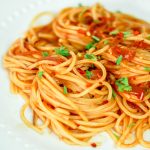

Leave a Reply